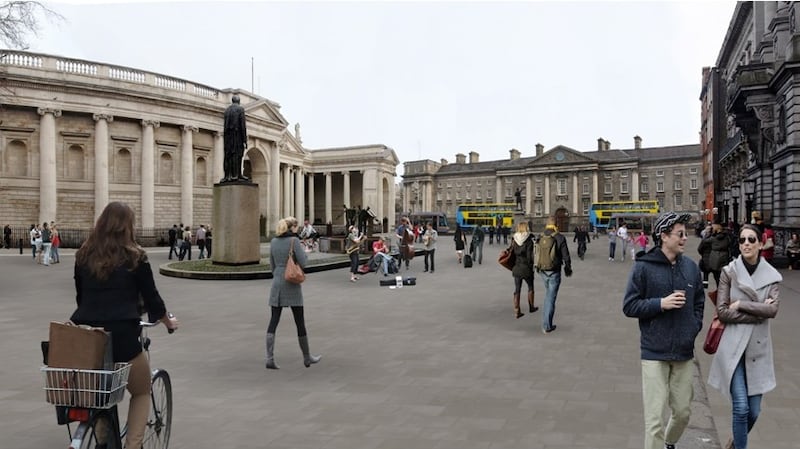Dublin City Council’s plans for College Green have been criticised by planners and academics at a conference on sustainable urban living spaces.
The EU-supported conference, hosted by the city council, featured a number of contributors who said redeveloping city spaces with hard concrete, tar and stone surfaces was “old-fashioned thinking”.
The city council plans to transform the area in front of the Bank of Ireland, the former Parliament House, into a major pedestrian plaza stretching the full width of the street. The design envisages a ban on vehicular traffic, including buses and taxis, and conceptual illustrations show the area without existing plane trees.

Sofie Vanderwoestijne of the European Commission’s Directorate-General for Research and Innovation said designing modern urban spaces for healthy living involved designing “more nature and natural features into cities”.
She said “renaturing cities” was vital in creating “resilient cities which are inclusive of communities” and which “promote culture”.
She said the biggest EU Research and Innovation programme, Horizon 2020, which offered nearly €80 billion of funding between 2014 to 2020, envisaged living, innovative, well-designed, urban communities.
Referring specifically to plans to remove trees and redevelop College Green as a public transport and pedestrianised space, Dr Marcus Collier of the UCD School of Geography said the “mistake” was the “greying” of College Green, rather than the “greening” of it.
‘Old-fashioned thinking’
Dr Collier said creating “grey” spaces was “old-fashioned thinking which dates from the 1970s when we thought modern cities would be all concrete and steel”. He said “we now know they need to be much greener than that - for economic, sustainable and biodiversity reasons”.
He said issues such as climate change, flood management, drainage and biodiversity had dictated a greener approach, and while city authorities had to constantly reinvest in grey surfaces, green ones were more economically viable and promoted employment.
Asked if he was calling for a “greener” approach to the design of College Green, he said he was not calling for this - “we are demanding it”.
The irony is that the space in question is called “College Green” in the first place he said.
The conference was jointly organised between the international organisation for collaboration Turas - Towards Urban Resilience and Sustainability - and the City Council. A number of delegates recounted their experience with greening their open spaces, including the experience of London’s Rubens Hotel, which created a “living wall” .
Seasonal plant species
The 21m-high wall at the side of the hotel is packed with over 20 seasonal plant species including buttercups, crocuses, strawberries, lavender, spring bulbs and winter geraniums. The flowers have been chosen to ensure the wall is “in-bloom” all year round.
Hans Muller of Helix Pflanzen GmbH recounted how “urban heat island effects” can be observed during summer days in Ludwigsburg, near Stuttgart, Germany.
A significant problem is the high concentration of particulate matter (PM10) pollution along the main roads in the city centre, while the loss of biodiversity is ongoing. But he said the city was fighting back with green “urban climate comfort zones” - green areas which provide shade and a softer environment in which to foster biodiversity.












